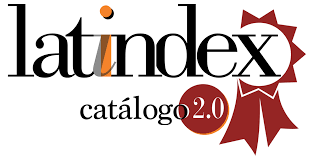Glass ceiling and public relations: The problematic in the disciplinary field in Argentina
DOI:
https://doi.org/10.5783/revrrpp.v12i24.787Keywords:
gender, glass ceiling, public relations, inequality , ArgentinaAbstract
The following research is carried out at the Faculty of Social Sciences of the National University of Lomas de Zamora (Argentina) and is part of a broader project on "Transdisciplinary approaches in the Social Sciences in addressing gender issues", where eight (8) research teams worked articulately on lines that link different gender issues addressed from different disciplines of the Social Sciences. A transdisciplinary methodology was adopted to articulate and rethink from different points of view that provide diverse perspectives on the problems associated with gender issues, which do not admit simple or linear explanations.
The beginning of this project is marked by a social and political context in the region that challenges society, and therefore the professional field of any discipline, and promotes analysis of the situation of women in the profession.
Since there is no specific data about public relations in Argentina, it is hoped that the results of this research can provide information to understand the situation of women in this field in relation to the glass ceiling.
The situation was analyzed from the concepts of the glass ceiling, understood as those invisible barriers that women face when they try to ascend in the hierarchical levels of the organization and strongly associated with these impediments in the growth of women, the concepts of : “Sticky Floor” -which explains how women, having to take care of their families; they put aside their continuous training outside of their working hours, they have more difficulties to attend events outside of work, etc. (Upegui Valencia and Cervera Delgado, 2009)- and "male brotherhoods" (Segato, 2010) -or those informal but exclusively masculine spaces that enable the formal promotion of men in organizations-.
A qualitative and quantitative methodology has been used, in which more than 250 self-administered surveys (non-probabilistic randomized) and 17 in-depth interviews with leading PR professionals in Argentina have been analyzed, with the aim of investigating the perceptions of professionals about the phenomenon of the "glass ceiling" in the field of PR in Argentina, its origins, possible explanations, and their experiences in this regard, providing a holistic view of this problem.
Given the lack of data on the specific topic of glass ceiling and Public Relations in Argentina, it is expected that the results of this research can provide information to understand what the situation of women in this field is and generate contributions that aim to reduce asymmetries.
The final results confirm that there are phenomena in the profession that are recurrent in different regions of the world (for example, the feminization of the profession, the glass ceiling, stereotypes associated with gender, the existence of masculine brotherhoods) and yet in the study, other phenomena appear that contradict some theories and that allow to think of alternative ways to address this social problem.
From the role in university teaching, the proposal is the co-construction and co-creation of educational and discursive strategies (Herrera Echenique and Bendezú, 2020) where it is essential to adopt listening as a pedagogical position: conditions must be generated for a new type of society, more inclusive, fair, and egalitarian.
Downloads
References
ADI, A. Y AYME-YAHIL, E. (2020) Women in PR. Research and opinions about the status, challenges and future of women working in PR/Communications. Berlin: Quadriga University of Applied Sciences.
ÁLVAREZ-NOBELL, A.; MOLLEDA, J. C.; MORENO, A.; ATHAYDES, A.; SUÁREZ-MONSALVE, A. M. Y HERRERA, M. (2021). Comunicación estratégica y relaciones públicas en América Latina: crisis del COVID-19 en la gestión de comunicación, ciberseguridad, situación de las mujeres, retos éticos y nuevas competencias. Resultados de una encuesta en 20 países. Bruselas: EUPRERA. https://latincommunicationmonitor.com/wp-content/uploads/2021/09/Informe-Final-LCM-2020-2021-v0.2.pdf
BURIN, M. (2008). Las “fronteras de cristal” en la carrera laboral de las mujeres. Género, subjetividad y globalización. Anuario de Psicología, 39 (1), 75-86. https://raco.cat/index.php/AnuarioPsicologia/article/view/99355.
BURIN, M. (2012, 7 de junio). El techo de cristal, aun en los cielos. Psicología, 12. https://www.pagina12.com.ar/diario/psicologia/9-195792-2012-06-07.html
CARBONE, C. Y CANELLA TSUJI, L. (2020). Public Relations Professionals and the Glass Ceiling in Argentina, en ADI, A. Y AYME-YAHIL, E. (Eds.) Women in PR. Research and opinions about the status, challenges and future of women working in PR/Communications (pp. 69 – 79). Berlín: Quadriga University of Applied Sciences.
CHARLO MOLINA, M. J. Y NUÑEZ TORRADO, M. (2012). La mujer directiva en la gran empresa española: perfil, competencias y estilos de dirección. Estudios Gerenciales, 28 (124), 87-105. https://www.redalyc.org/articulo.oa?id=21226247005
DELFINO, A., HERZFELD, C. Y ARRILLAGA, H. (2018). Trabajo no remunerado y uso del tiempo en la Argentina de principios del siglo XXI. Sociedad y Economía, (34), 167-184. https://dx.doi.org/10.25100/sye.v0i34.6477
DIRECCIÓN NACIONAL DE ECONOMÍA, IGUALDAD Y GÉNERO (2020). Los cuidados, un sector económico estratégico. Medición del aporte del trabajo doméstico y de cuidados no remunerado al Producto Interno Bruto. Ministerio de Economía. Secretaría de Política Económica.https://back.argentina.gob.ar/sites/default/files/los_cuidados_-_un_sector_economico_estrategico_0.pdf
FERNÁNDEZ, R. M. Y CAMPERO, S. (2017). Gender sorting and the glass ceiling in high-tech firms. ILR Review, 70(1), 73-104. https://doi.org/10.1177/0019793916668875.
FORO DE PERIODISMO ARGENTINO (2018). Mujeres Periodistas en la Argentina. Situación laboral y rol profesional de las comunicadoras en el país. https://www.fopea.org/mujeresperiodistas/descargas/estudio-mujeres-periodistas-2018.pdf
GARCÍA, R. (2007). Sistemas complejos. Conceptos, método y fundamentación epistemológica de la investigación interdisciplinaria. Barcelona: Gedisa.
GÓMEZ COLELL, E., MEDINA-BRAVO, P., FERNÁNDEZ-ABALLÍ, A., JIMÉNEZ, M. Y OBRADORS, M. (2016). El grado de publicidad y relaciones públicas, cuestión de género. Revista de Ciencias Opción, 32 (11), 668-676
GUZZETTI, L. (2014). La intervención social, mirada desde la perspectiva de género. Plaza Pública, 7 (11), 76-88. https://revistaplazapublica.files.wordpress.com/2015/03/11-6.pdf
HERRERA ECHENIQUE, R. Y BENDEZÚ UNTIVEROS, R. (2020). De La Comunicación Instrumental a la Estratégica en Bicalho Félix, J. (Org.). Comunicação estratégica e integrada. A Visão de 23 Renomados Autores de 5 Países (pp.105-140). Brasilia: Editora Rede Integrada.
HYMOWITZ, C. Y SCHELLHARDT, T. D. (1986, 24 de marzo). The glass ceiling. Wall Street Journal, 1D, 4D.
KHALIL-TOLOSA, N., FUENTES-LARA, C., & VERHOEVEN, P. (2019). Las mujeres comunicadoras y relacionistas públicas en Costa Rica. Una aproximación a su perfil profesional. ComHumanitas: Revista Científica De Comunicación, 9(2), 51-65. https://doi.org/10.31207/rch.v9i2.165
MESSINA, G. M. (2017). Trabajo, uso del tiempo y Estado de bienestar: desigualdades de género en la Argentina. Lavboratorio, 27(6), 11-32. https://ri.conicet.gov.ar/handle/11336/76961
MORENO, A., FUENTES LARA, C. Y KHALIL, N. (2018). Gendercom: Brechas y oportunidades de género en la profesión de Gestión de la Comunicación en España. Madrid: Asociación de Directivos de Comunicación. https://www.dircom.org/wp-content/uploads/2021/04/Informe-Gendercom.pdf.
MORIN, E. (1994). Introducción al pensamiento complejo. Barcelona: Gedisa
MOSTO, C. (2012). Análisis del mercado de las Relaciones Públicas. En Estudio preliminar cuali/cuantitativo realizado por CIO para el Consejo Profesional de Relaciones Públicas. Buenos Aires, Argentina, Noviembre 2012 (no publicado).
SECRETARÍA DE POLÍTICAS UNIVERSITARIAS (2020). Informe sobre graduados de Relaciones Públicas período 2011 - 2018 (no publicado, comunicación personal).
SEGATO, R. (2010). La Argamasa Jerárquica: Violencia moral, reproducción del mundo y la eficacia simbólica del Derecho en Las estructuras elementales de la violencia. Ensayos sobre género entre la antropología, el psicoanálisis y los derechos humanos. (2da ed.). Buenos Aires: Prometeo.
UPEGUI VALENCIA, A. M., y CERVERA DELGADO, C. (2018). Techo de cristal y suelo pegajoso: estudios de género en la academia. Jóvenes en la ciencia, 4(1), 1844–1848. https://www.jovenesenlaciencia.ugto.mx/index.php/jovenesenlaciencia/article/view/2886
WRIGLEY, B. (2002). Glass Ceiling? What Glass Ceiling? A Qualitative Study of How Women View the Glass Ceiling in Public Relations and Communications Management, Journal of Public Relations Research, 14 (1), 27-55. https://doi.org/10.1207/S1532754XJPRR1401_2.
Downloads
Published
How to Cite
Issue
Section
License
Copyright (c) 2022 Revista Internacional de Relaciones Públicas

This work is licensed under a Creative Commons Attribution-NonCommercial-NoDerivatives 4.0 International License.
Authors publishing in this journal agree to the following terms:
a. Authors retain copyright and grant the journal the right to be the first publication of the work as licensed under a Creative Commons Attribution License that allows others to share the work with an acknowledgement of authorship of the work and initial publication in this journal.
b. Authors may separately enter into additional arrangements for non-exclusive distribution of the version of the work published in the journal (e.g., placing it in an institutional repository or publishing it in a book), with an acknowledgement of initial publication in this journal.
c. Authors are allowed and encouraged to disseminate their work electronically (e.g. in institutional repositories or on their own website) before and during the submission process, as it can lead to productive exchanges, as well as earlier and higher citation of published work (see The Effect of Open Access).





